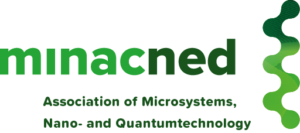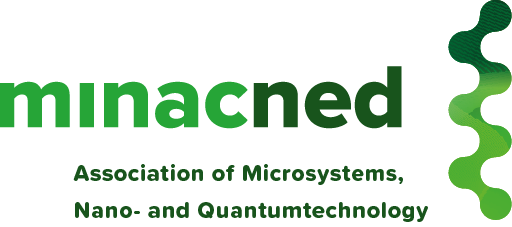Ronny, can you tell us something about your history with nanotechnology?
My passion for micro- and nanotechnology was sparked almost 25 years ago when I started my education at the University of Twente. During the course of my studies, I applied microtechnology to create a tool for DNA stretching experiments in a microfluidic device. By the end of my education, I developed the ambition to bring products with micro- and nanotechnology to the market.
When a few years later MinacNed was founded, I decided to become a member. Based on that relationship, I was asked to join the board. And a few years later, I became the president of MinacNed. I consider it an honour to be part of this board as I believe the society as a whole will benefit from micro- and nanotechnology. To make a success out of a product and the industry behind it, you need to work together with others. This is exactly what MinacNed facilitates. It brings together companies and institutes working in microsystems and nanotechnology. By working together, the chances to make a difference in the field are increasing.
Twenty year celebration of your company Micronit
In 2020, Micronit will celebrate its twenty year anniversary. As a microfluidics specialist, the company focusses on health and life sciences. Microfluidics is an important enabler of many techniques in medical research, like blood analysis. Next to that, it is also vital in for instance the unraveling of the human genome. In the long run, I strongly believe in point of care, which means bringing the lab to the patient, instead of the patient to the lab. Workflow integration of lab equipment – in other words, taking different steps of a lab research process and integrating them into one device – will result in a next generation of equipment with ease of use and increased data quality. All these processes are only possible because of the current status of micro- and nanotechnologies in the Netherlands.
What challenges and hardships have you faced and conquered in your experience as entrepreneur? What advice do you want to give companies attending iMNC19?
I think the best advice I can give technology companies is to always focus on the customers. In the end you can’t sell technology as such. Secondly, I would advise them to interact with the customers. Also make sure you talk to your customers in parallel to the technology development. By keeping in touch, you can do the right finetuning along the way. There’s nothing more devastating than having a ready product that won’t sell because it just isn’t functional for the intended customer. In the early days I was hesitant to call customers and ask them for advice. But at a certain point, after realizing how important it is, it became my second nature. Because in the end, a company without customers is not a company.
Last advice: a great place to learn from other entrepreneurs and meet potential customers is the iMNC19!
What kind of change have you experienced in microsystems and nanotechnology in the past twenty years?
I think a lot of things have changed in the past twenty years. The readiness level on average has dramatically improved. With this I mean: twenty years ago, the challenges were on the engineering level (‘how can we make this device work?’). As for now, we operate more solution-driven (‘how can we put our technology in use to solve this problem for this market?’). There are more players in the field and together we have matured. More players means a fuller but also ‘richer’ market with more segments represented that are complementary to each other. This way, the impact the technology as a whole can make, only gets bigger. Our market has grown substantially. In my view, most microtechnology related markets grow 10-20% on average on a yearly base. There are not many worldwide markets that grow that fast.
What are the current developments in micro- and nanotechnology and which companies can you name that are really innovating?
I think all of the members of MinacNed are contributing to new developments. Nanotechnology as key enabling technology has a lot of different appearances. If you combine nanotechnology with light, you call it photonics. Combining nanotechnology with quantum physics, creates quantum computing. Combine nanotechnology with fluids and cells, and you have organ-on-a-chip. The possibilities of exciting innovations in nanotechnology are endless, provided that we keep working together and investing in it. MinacNed serves as an excellent platform for this.
What makes MinacNed unique?
MinacNed is Netherlands-based, but internationally orientated. Almost all MinacNed-members are already working internationally or have plans to do in the short term. MinacNed has created an ecosystem that knows how to bridge the gap from research to market ánd has knowledge about how to bring products to the international market. All nano-oriented SME’s that are united in MinacNed, are key to this.
Let’s look five years ahead. From the point of view of your twenty years of experience in micro- and nanotechnology: what can we expect in 2024?
What I have noticed, is that at the moment there are a lot of companies in the scale-up phase. This unique development can also be witnessed by current data that show that micro- and nanotechnology is growing faster in the Netherlands than worldwide. If we keep investing in these technologies, I think this growth might even accelerate. Besides that, in 2024 the amount of products that are really on the market will have grown substantially and with this, the added value of the industry will have grown significantly.
The iMNC19 is around the corner. Why should companies attend the conference?
It’s a great place to get a good view on the state of micro- and nanotechnology in the Netherlands. Besides that, it provides excellent international networking opportunities. Overall, it is a great place to do business and make connections. The most important part to me personally: it is simply a lot of fun to be among people that share the passion for nanotechnology.

 Looking forward to seeing and meeting you in person.
Looking forward to seeing and meeting you in person.
